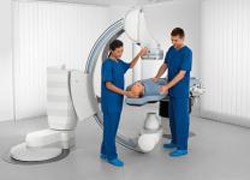Less radiation during catheter interventions

Siemens Healthcare has integrated the navigation technology MediGuide from St. Jude Medical into its Artis zee angiography systems. By means of magnetic targeting, MediGuide locates the catheter during cardiac interventions and projects its precise position in realtime on a previously acquired fluoroscopy image of the patient.
This technology has great potential to save radiation dose during long procedures as the patient does not need to be scanned repeatedly with the angiography system in order to track the catheter. Navigation with the MediGuide Technology from St. Jude Medical utilizes a special electromagnetic tracking procedure to determine the position of medical devices during minimallyinvasive interventions.
Siemens is the first manufacturer to integrate MediGuide Technology into its Artis zee systems to provide improved navigation of catheters during electrophysiology procedures without having to subject the patient to continuous fluoroscopy. During the intervention, a miniaturized sensor integrated into the catheter can be located by receiving electromagnetic positioning signals from the MediGuide transmitters, which are incorporated into the detector housing of the Artis zee system. The MediGuide Technology then calculates the respective position and orientation of the catheter and displays it in real-time on fluoroscopic images of the patient that were recorded earlier. To display the catheter’s position precisely, the technology also compensates for patient movement caused by respiration and heart motion.
The MediGuide Technology may provide significant benefits especially during longer interventions or examinations in the cath lab. The cardiologist no longer has to take fluoroscopic images of the patient each time the catheter is re-positioned, as is the case with current technology. As a result, less radiation and less contrast agent use is expected. “With the MediGuide Technology, we have expanded our CARE dose-reduction initiative with a critical functionality,” said Dr. Heinrich Kolem, Head of the Angiography & Interventional X-ray business unit at Siemens Healthcare.
“We are convinced that our customers will achieve better clinical results, especially during complex procedures, and at the same time will be able to save both dose and time.”
The Heart Center Leipzig, Germany, has already performed the first interventions with Artis zee and the MediGuide Technology. “The low-radiation, precise localization of the catheter tip onto the pre-recorded fluoroscopy image is a most impressive function, because the system is able to compensate the motion from heart beat and breathing,” said Professor Dr. Gerhard Hindricks, Director of the Rhythmology Department. “For my team and me, this is clearly the future in electrophysiology.” Dr. Christopher Piorkowski, MediGuide Project Team Leader at the Heart Center Leipzig, added: “Our clinical experience now includes more than 50 patients. The technology will have a significant impact in the field of catheter ablation, but also for the placement of left ventricular leads for cardiac resynchronization.”
The products mentioned here are not commercially available in all countries. Due to regulatory reasons the future availability in any country cannot be guaranteed. Further details are available from the local Siemens organizations.
St. Jude Medical develops medical technology and services that focus on putting more control into the hands of those who treat cardiac, neurological and chronic pain patients worldwide. The company is dedicated to advancing the practice of medicine by reducing risk wherever possible and contributing to successful outcomes for every patient. St. Jude Medical is headquartered in St. Paul, Minn. and has four major focus areas that include: cardiac rhythm management, atrial fibrillation, cardiovascular and neuromodulation.
For more information, please visit. www.sjm.com.
The Siemens Healthcare Sector is one of the world’s largest healthcare solution providers and a leading manufacturer and service provider in the fields of medical imaging, laboratory diagnostics, hospital information technology and hearing instruments. It offers solutions covering the entire supply chain under one roof – from prevention and early detection to diagnosis and on to treatment and aftercare. By optimizing clinical workflows oriented toward the most important clinical pictures, Siemens also strives to make healthcare faster, better and, at the same time, less expensive. Siemens Healthcare currently has some 48,000 employees worldwide and is present throughout the world. During fiscal 2010 (up to September 30) the Sector posted sales worth 12.4 billion euros and profits of around 750 million euros.
Media Contact
More Information:
http://www.siemens.com/healthcareAll latest news from the category: Medical Engineering
The development of medical equipment, products and technical procedures is characterized by high research and development costs in a variety of fields related to the study of human medicine.
innovations-report provides informative and stimulating reports and articles on topics ranging from imaging processes, cell and tissue techniques, optical techniques, implants, orthopedic aids, clinical and medical office equipment, dialysis systems and x-ray/radiation monitoring devices to endoscopy, ultrasound, surgical techniques, and dental materials.
Newest articles

NASA: Mystery of life’s handedness deepens
The mystery of why life uses molecules with specific orientations has deepened with a NASA-funded discovery that RNA — a key molecule thought to have potentially held the instructions for…

What are the effects of historic lithium mining on water quality?
Study reveals low levels of common contaminants but high levels of other elements in waters associated with an abandoned lithium mine. Lithium ore and mining waste from a historic lithium…

Quantum-inspired design boosts efficiency of heat-to-electricity conversion
Rice engineers take unconventional route to improving thermophotovoltaic systems. Researchers at Rice University have found a new way to improve a key element of thermophotovoltaic (TPV) systems, which convert heat…



